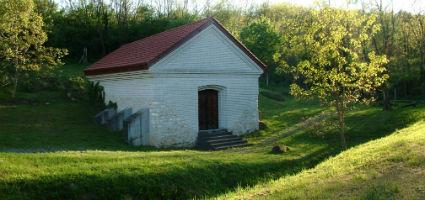2024. April 26. Friday
Sopron Museum - Mithras-sanctuary - Fertőrákos
 |
Address: 9421, Fertőrákos Fertőrákos, Osztrák-Magyar biciklis átkelőhely
Phone number: (99) 311-327
E-mail: sopronimuzeum@gmail.com
Opening hours: On prior notice
|
In the provinces of the gigantic Roman Empire men had only one chance for advancement, and that was to enter the legions. After having served 20-25 years, they obtained citizenship and properties. They lived and fought far from their homes, and took their culture and religion wherever they went. The Mithras sanctuary was built in the 3rd century before Christ by Persian soldiers stationing in Carnuntum.
Mithras - symbol of the light and life - kills his enemy in a cave. The enemy, a bullock represents darkness and evilness. This is where the supper took place - Mithras ate the bullock.
The eastern and southern side of the sanctuary were rock walls, and the inner space was also made into the form of a cave. In front of the entrance there is the main cult picture, which is Mithras killing the animal. Besides the sides of the sanctuary platforms were formed for the spectators. The rite itself was executed in the middle. This cult was a religion of mistery, and as such it was kept secret from those not involved. Believers obtained the highest standard of knowledge through two steps. During the admission ceremony the believers had to lie flat in a hole, above which the bullock was killed. The blood of the animal secured admission for the person such involved.
The sanctuary, situating very close to the Hungarian-Austrian border - was discovered by Jun. Ferenc Storno. Excavations were done and protecting roofs were attached by elder Ferenc Storno. After World War I the area was totally deserted, so the sanctuary was altogether destroyed. Excavation works of 1990 and 1991 made it possible for us to get to know more about this unique religion.
The sanctuary can be reached by a half an hour walk from the roadsign pointing to Rákos.
Mithras - symbol of the light and life - kills his enemy in a cave. The enemy, a bullock represents darkness and evilness. This is where the supper took place - Mithras ate the bullock.
The eastern and southern side of the sanctuary were rock walls, and the inner space was also made into the form of a cave. In front of the entrance there is the main cult picture, which is Mithras killing the animal. Besides the sides of the sanctuary platforms were formed for the spectators. The rite itself was executed in the middle. This cult was a religion of mistery, and as such it was kept secret from those not involved. Believers obtained the highest standard of knowledge through two steps. During the admission ceremony the believers had to lie flat in a hole, above which the bullock was killed. The blood of the animal secured admission for the person such involved.
The sanctuary, situating very close to the Hungarian-Austrian border - was discovered by Jun. Ferenc Storno. Excavations were done and protecting roofs were attached by elder Ferenc Storno. After World War I the area was totally deserted, so the sanctuary was altogether destroyed. Excavation works of 1990 and 1991 made it possible for us to get to know more about this unique religion.
The sanctuary can be reached by a half an hour walk from the roadsign pointing to Rákos.
|
Permanent exhibitions
|
|